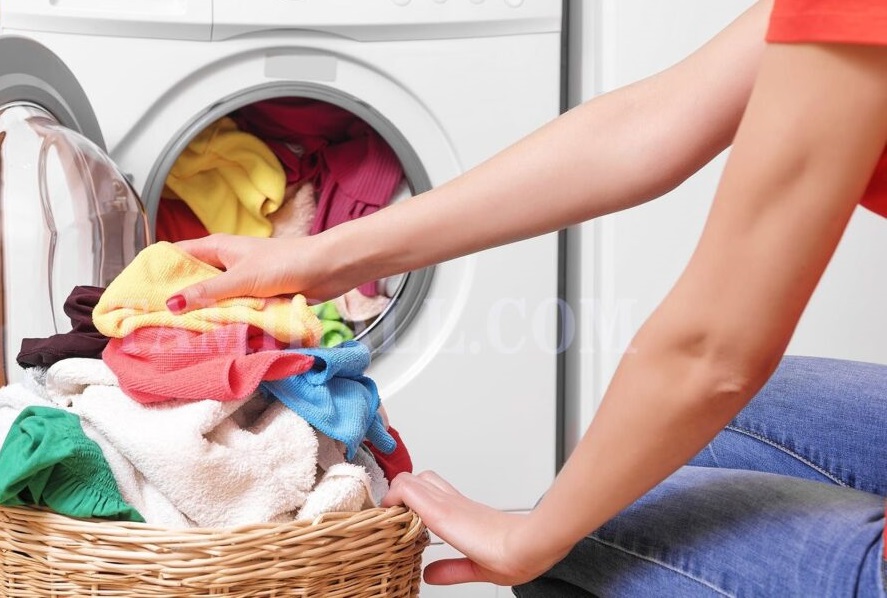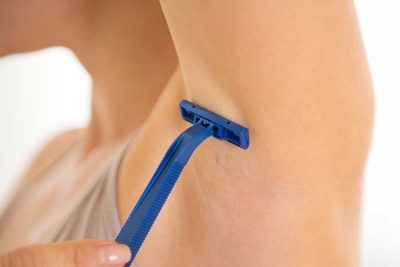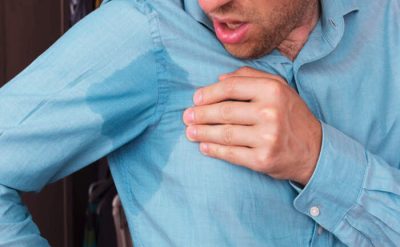The Underarm Area and Its Susceptibility to Skin Problems
The underarm area is prone to skin issues due to its thin skin and the presence of numerous sweat glands and hair follicles. This combination creates conditions where the likelihood of developing pimples increases. However, underarm pimples do not appear without reason—they are influenced by factors such as friction, shaving, and infections. Being aware of these factors helps you more easily find ways to treat them.
In this article from Darmankadeh Magazine, Dr. Fakhriya examines the causes of underarm pimples and introduces the best available treatment options.
Causes of Underarm Pimples
Pimples usually result from the accumulation of bacteria on the skin. When skin pores are blocked by bacteria, a small bump forms around them. The underarm is one of the most common areas for this to occur.
Although these pimples are usually harmless, they can be painful and uncomfortable, leading to issues like skin irritation, tenderness, and itching. Painless pimples generally do not require medical treatment and often resolve on their own. However, painful underarm pimples should be evaluated by a doctor.
What Does an Underarm Pimple Indicate?
Subcutaneous underarm pimples are a common problem experienced by many people at different stages of life. Various factors can contribute to their formation:
1. Folliculitis
Folliculitis is an infection affecting hair follicles, causing inflammation around them. It typically appears as red, pus-filled bumps around hair strands and is essentially a type of pus-filled pimple.
Causes of folliculitis may include bacterial or fungal infections. Sometimes, inflammatory skin conditions or certain prescription medications can trigger it. This condition is more common in people with weakened immune systems or those more prone to skin infections.
In many cases, folliculitis resolves on its own within a few days. However, large and painful pimples may require medical evaluation and treatment. Severe cases can lead to hair loss and permanent scarring.
Symptoms:
-
Pimples
-
Pain
-
Itching
-
Blisters
-
Skin irritation
2. Ingrown Hair
If you regularly shave your underarms, ingrown hairs may be the cause of your pimples. Shaving increases the likelihood of ingrown hairs. This occurs when hair strands bend and grow back into the skin. In other cases, dead skin cells may block hair follicles, causing hair to grow inward instead of outward. While not all ingrown hairs turn into large pimples, many become infected and form pus-filled bumps.
Symptoms:
-
Skin inflammation
-
Pus-filled bumps
-
Tenderness to touch
-
Itching
3. Contact Dermatitis
Pimples caused by contact dermatitis occur when the underarm skin comes into contact with substances that trigger sensitivity. This can include sprays, deodorants, or soaps. Even laundry detergents can cause pimples on the left and right underarms. Fortunately, contact dermatitis is not life-threatening and usually resolves within a few weeks.
Symptoms:
-
Flaky skin
-
Severe itching
-
Skin rashes
-
Blisters
-
Skin inflammation
4. Hidradenitis Suppurativa
Hidradenitis suppurativa, also known as acne inversa, is a chronic skin condition that repeatedly causes subcutaneous pimples. It primarily affects areas such as the underarms and groin.
The bumps often rupture, releasing fluid, and frequently leave scars. Although the condition may temporarily subside, pimple-like lesions often reappear.
Symptoms:
-
Recurrent pimples
-
Scarring
-
Foul-smelling discharge
5. Fungal Infection
Moist areas of the body are prone to fungal infections. The underarm, which frequently sweats, creates an ideal environment for the growth of Candida fungi. This fungus causes red, itchy pimples under the arms.
Symptoms:
-
Red pimples
-
Itching
-
Skin rashes
6. Razor Burn
Frequent shaving of underarm hair not only increases the risk of ingrown hairs but also irritates and sensitizes the skin. Due to its softness and sensitivity, underarm skin is easily damaged and roughened by razors, which can cause friction when moving the arms and lead to discomfort and burning sensations.
Razor burn typically occurs when the skin is not adequately moisturized before shaving or when old razors are used. Using worn razors may also transfer bacteria to tiny skin cracks, increasing the risk of skin infections such as folliculitis or boils, which often resemble pimples.
Symptoms:
-
Tender, irritated skin
-
Red, itchy rashes
7. Friction
The hands are among the most frequently used body parts, and constant movement causes the underarm skin to experience regular friction. This can increase the risk of wounds and skin infections, leading to inflammation and pimples in the underarm area.
Symptoms:
-
Discomfort in the underarm
-
Redness
-
Skin sensitivity to touch
Complications of Underarm Pimples
Most underarm pimples do not cause serious problems. However, neglecting them can lead to scarring or infection, often occurring if pimples are squeezed or if underarm hygiene is ignored.
When Are Underarm Pimples Dangerous and Require Medical Care?
People with painful underarm pimples are advised to see a dermatologist to determine the cause. Anyone unsure about the source of their rash or who has not found relief with home remedies should consult a doctor.
Pimples accompanied by the following symptoms require immediate medical evaluation:
-
Dizziness
-
Severe swelling
-
Fever
-
Bleeding or pus discharge
-
Nausea, vomiting, or diarrhea
How to Treat Underarm Pimples
Pimples usually do not require medical treatment and often resolve within one to two weeks with home care. However, if they are accompanied by bleeding, pus, severe pain, or other unusual symptoms, medical attention is necessary. Depending on the cause, a doctor may prescribe oral or topical medications, including antibiotics, steroid creams, or antibacterial lotions.
1. Home Remedies
Most pimples can be managed at home. Try the following methods:
-
Wash underarms with products containing chlorhexidine gluconate or benzoyl peroxide to remove bacteria and maintain hygiene.
-
Keep the underarm area dry, as sweat and moisture accumulation are common causes of pimples.
-
Avoid shaving with a razor; use unscented soap or cleansers instead. After skin recovery, consider alternative hair removal methods like laser treatments.
2. Antibiotics
The human body hosts various bacteria, so antibiotics are a common treatment for pimples. Antibiotics such as cephalexin, doxycycline, and erythromycin eliminate the bacteria causing pimples. Self-medication is not recommended, especially for individuals with underlying conditions or allergies. Consulting a doctor helps reduce the risk of serious side effects.
3. Topical Ointments
Topical products can also be used to treat pimples:
-
Antibacterial gels and lotions (e.g., erythromycin, clindamycin): Effective for bacterial infections like folliculitis.
-
Benzoyl peroxide gels or creams: Most effective at low concentrations (2–5%). Higher concentrations may irritate the skin.
-
Steroid creams: Reduce pimple symptoms, including inflammation and irritation.
How to Drain Underarm Pimples
Some people try to drain pimples at home by exposing the area to steam to open the pores, then gently squeezing the pimple. However, dermatologists do not recommend this, as bacteria may penetrate deeper layers of skin, causing pain, inflammation, or scarring.
Preventing Underarm Pimples
To prevent pimples in the underarm area, follow these tips:
-
Use razors correctly: Razors can cause ingrown hairs and irritation. Consider alternatives like laser hair removal. If using a razor, ensure it is clean, shave in one direction, and do not use it more than five to seven times.
-
Exfoliate underarm skin: Exfoliation removes excess oil (sebum) and keeps pores open, helping prevent pimples.
-
Maintain hygiene: Keep underarms clean. Shower and change clothes after work or physical activities like running or swimming. Daily hygiene is crucial for preventing skin problems.
-
Avoid friction: Continuous friction can cause irritation and pimples. Loose, cotton clothing reduces friction and allows the skin to breathe.

Change and wash your clothes regularly to minimize the risk of pimples.
-
Avoid allergens: Contact dermatitis or allergic reactions are common causes of underarm pimples. Avoid soaps or detergents that trigger sensitivity.
-
Choose products suitable for your skin type: Consult a dermatologist before buying hygiene products. Selecting gentle, skin-appropriate products helps prevent irritation and pimples.
Conclusion
Underarm pimples are common and usually harmless, but they can be painful and annoying. They may be caused by folliculitis, ingrown hairs, contact dermatitis, fungal infections, hidradenitis suppurativa, razor burn, or friction. Maintaining hygiene, keeping the area dry, using appropriate skincare products, and avoiding irritation can help prevent and improve pimples. In severe cases, medical consultation and treatment are necessary.
If underarm pimples concern you, we recommend consulting top dermatologists via drfakhriya.com
Frequently Asked Questions
What causes underarm pimples in children?
Excessive sweating and contact with detergents are the most common causes in children.
What is the best home remedy for underarm pimples?
Keeping the underarm dry, avoiding shaving with a razor, and using products containing chlorhexidine gluconate or benzoyl peroxide can be helpful.
When should I see a doctor for underarm pimples?
See a doctor if pimples are accompanied by pain, fever, severe swelling, bleeding, pus, or if home treatments fail.
Sources: SkinKraft | RevivalResearch




